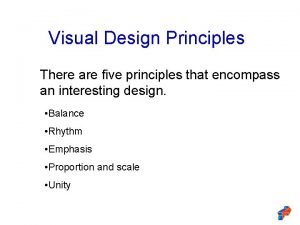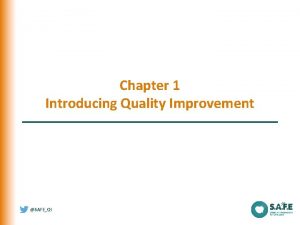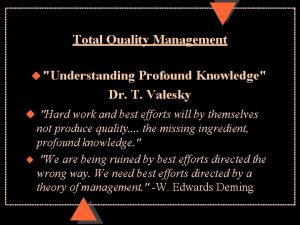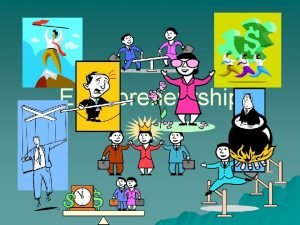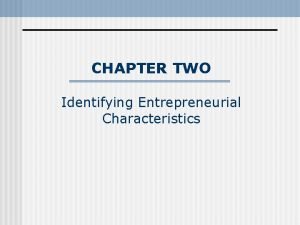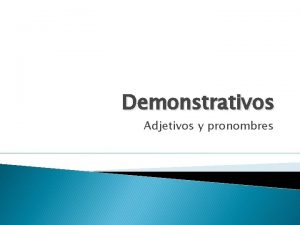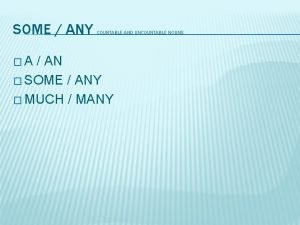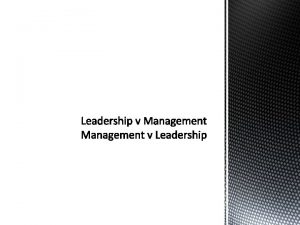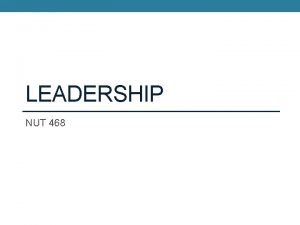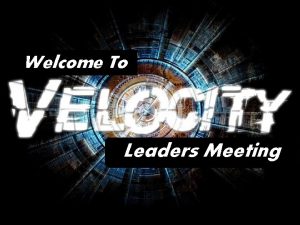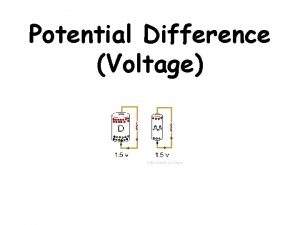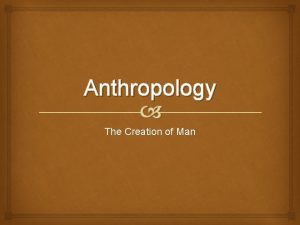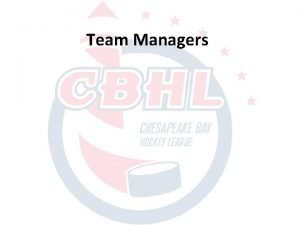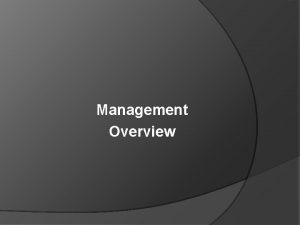Leaders vs Managers There is a profound difference






























- Slides: 30

Leaders vs. Managers “There is a profound difference between management and leadership, and both are important. To manage means to bring about, to accomplish, to have charge of or responsibility for, to conduct. Leading is influencing, guiding in a direction, course, action, opinion. The distinction is crucial. ’ (Warren Bennis, a distinguished expert in the field of leadership styles. )

Chapter 10 Management & Leadership

EQ: What are the traits of an effective manager and how does he or she lead others?

Learning Objectives v Understand the main functions of managers v Analyze the importance of good management to the success of a business v Analyze the differences between Mc. Gregor's Theory X and Theory Y v Recognize the key differences in management styles v Evaluate the appropriateness of these styles to different business situations v Understand the significance of informal leadership v Analyze the four competencies of emotional intelligence.

Badly managed businesses v Poorly organized v Poor staff motivation v Resources wasted or used inefficiently v Lack long-term plans or objectives v Lack direction and purpose

Key concept What is a Manager? A manager is a business professional that sets the objectives, organizes resources and motivates staff so that the organizations aims are met

Functions of management Key concept Managers’ responsibilities v Setting objectives and planning – thinking ahead and planning is a key component for any manager. v Organizing Resources – ensuring you have enough staff and the right staff to achieve the organizations objectives. v Directing and Motivating Staff – ensuring staff are on task and achieving set objectives.

Functions of management - Key concept Managers’ responsibilities v. Coordinating Activities – ensuring consistency and coordination between departments within a business. (reduces communication issues) v. Controlling and Measuring performance – ensuring that each department performs at the levels expected. (set out in corporate objectives) Provide positive feedback.

Key concept Mintzberg’s 3 Management Roles Henry Mintzberg (The Nature of Managerial Work, 1973) v Identified 10 roles of managers v Roles divided into 3 groups 1. Interpersonal Roles 2. Informational Roles 3. Decisional Roles

Key concept Mintzberg’s 3 Management Roles #1 - Interpersonal Roles - Figurehead – Symbolic leader of organization i. e. Richard Branson (Virgin) - Leader – Motivating, selecting and training staff. - Liaison – Linking with managers from other branches and divisions.

Key concept Mintzberg’s 3 Management Roles #2 - Informational Roles - Monitor – collecting data relevant to business organization. - Disseminator – sending data collected to the relevant people within an organization. - Spokesperson – Communicating with media and other sources about the organization.

Key concept Mintzberg’s 3 Management Roles # 3 - Decisional Roles - Entrepreneur – The ideas person. - Disturbance Handler – Handling issues within a business and anything that will put a business at risk. - Resource Allocator – Deciding how the business spends its money and allocates physical and human resources. - Negotiator – representing the organization in important negotiations.

Key concept Leadership v Leadership is a key part of being a successful manager v Charismatic leaders set a clear direction & vision v The best managers are good leaders v Managers focusing too much on control of staff and resources – Provides no sense of purpose or focus – Fail to inspire workers to take a fresh direction What makes a good leader?

Key concept Leadership Characteristics v Desire to succeed and have a natural self confidence v Creativity - think outside the box v Multi-talented understands all aspects of the business. v Gets to the heart of the issue rather than wasting time on unnecessary details.

Leadership positions in Business v. Top executives – CEO, CFO, COO… v. Directors – elected by shareholders v. Managers – responsible for people, resources or decision-making v. Supervisors – appointed by management to watch over the work of others v. Worker representatives (Union Rep) – elected by the workers, to discuss areas of common concern with managers

Stop and think!!! By now you should be able to…… 1. Identify and explain the key functions of management. 2. Identify and explain Mintzberg’s roles of management 3. Explain the importance of leadership. 4. List and explain key leadership positions in business.

Do Now - 3/5/2021 Ch. 10 Management & Leadership Type a Response to the 2 questions on Edmodo.

Key concept Leadership Styles - Autocratic Main Features v Autocratic Drawbacks q Leader takes all q Demotivates staff decisions who want to q Gives little contribute and information to staff accept responsibility q Supervises workers q Decisions do not closely one-way benefit from staff communication input q Workers given limited information about the business Possible applications q Defense forces and police where quick decisions are needed and the scope for discussion must be limited q Times of crisis when decisive action might be needed to limit damage to the business or danger to others

Key concept Leadership Styles - Democratic Main Features v Autocratic Drawbacks q Participation q Consultation with encouraged staff can be timeq Two-way consuming communication used, q On occasions, quick which allows decision-making will feedback from staff be required q Workers given q Level of involvement information about – some issues might the business to allow be too sensitive (e. g. full staff involvement job losses) or too secret (e. g. development of new products) Possible applications q Most likely to be used in businesses that expect workers to contribute fully to the production and decision-making processes q An experienced and flexible workforce q Situations that demand a new way of thinking or a new solution

Key concept Leadership Styles - Paternalistic Main Features v Autocratic Drawbacks Possible applications q Managers do what q Some workers will be q Used by managers they think is best for dissatisfied with the who have a genuine the workers apparent attempts concern for workers’ q Some consultation to consult, while not interests, but feel might take place, but having any real that ‘managers know the final decisions power of influence best’ in the end are taken by the q When workers are managers – there is young or no true participation inexperienced this in decision-making might be an q Managers want appropriate style workers to be happy in their jobs

Key concept Leadership Styles – Laissez-faire Main Features v Autocratic Drawbacks q Managers delegate q Workers may not virtually all authority appreciate the lack and decision-making of structure and powers direction in their q Very broad criteria or work – this could limits might be lead to a loss of established for the security staff to work within q The lack of feedback – as managers will not be closely monitoring progress – may be demotivating Possible applications q When managers are too busy (or too lazy) to intervene q May be appropriate in research institutions where experts are more likely to arrive at solutions when not constrained by narrow rules or management controls

Key concept Views differ over the most appropriate leadership style for creating value in a business. Some managers believe that an autocratic style will encourage the workforce to work efficiently to create value. Other managers consider that a laissez-faire or democratic style is most appropriate to bring the best out of a workforce.

Activity 10. 3 Autocratic, Democratic, Laissez-faire? Which style of leadership might be most appropriate in the following situations: 1. Business is flooded and important inventory and company records have been damaged. 2. Electronics company plans to establish a group to research into new types of batteries. 3. The quality of output from a pipe manufacturing factory has declined and no one knows why. The production team have been asked to attend a meeting about the problem.

Key concept Mc. Gregor's Theory X and Theory Y Douglas Mc. Gregor's research concluded that the style of leadership used by a manager is a direct response to there attitude towards there employees. Theory X managers believe their workers are lazy , dislike work and aren't prepared to accept responsibility because of this they need to be controlled and made to work. Theory Y managers believed staff enjoyed work, would be prepared to accept responsibility, were creative and took an active part in contributing ideas and solutions to work related problems.

Leadership Styles v What is the best style of leadership? Because every business is different and every workforce is different there is no one right style and managers will sometimes switch between a few depending on the circumstance. v Some factors that may influence leadership style will include the training and experience of the workforce, the amount of time available to make a decision, the attitude of managers and the importance of the issues under consideration.

Key concept Informal Leadership This is very common in the workplace, often there will be people within an organisation who other staff will follow despite not having any formal responsibility. This is a tricky situation for managers as they can’t exclude the employee as there opinion carries weight with the rest of the staff, and its hard to promote them because they are likely to lose there influence with the staff because of being seen as having gone to the dark side. Working alongside the informal leader to ensure business aims are met is crucial.

Key concept Emotional Intelligence v. The ability to understand your emotions and your staffs emotions to ensure a better business performance. v. This is a very new area of research but because business is a very people oriented environment the brightest person in academic terms may not be the best at managing staff where as someone with a higher EQ is likely to do a better job.

Emotional Intelligence Four main competencies for managers. 1. Self Awareness – Having self confidence in our abilities. 2. Self Management – Being able to manage our behaviour despite the situation. 3. Social Awareness – ‘Reading’ people and taking there views into account, being able to relate to a wide range of individuals. 4. Social Skills – Being able to use social skills to lead and motivate staff, and interpreting social interactions correctly.

Stop and think!!! By now you should be able to…… 1. Identi

Key Terms 1. 2. 3. 4. 5. 6. 7. 8. Manager (p. 126) Leadership (p. 126) Autocratic leadership (p. 128) Democratic leadership (p. 129) Paternalistic leadership (p. 130) Laissez-faire leadership (p. 130) Informal leader (p. 133) Emotional intelligence (EI) (p. 133)
 7 seismic shifts
7 seismic shifts Graduated rhythm
Graduated rhythm System of profound knowledge
System of profound knowledge It represents dignity formality, stability and strength
It represents dignity formality, stability and strength Emotional permanence
Emotional permanence Deming's theory of profound knowledge
Deming's theory of profound knowledge Henri fayol spouse
Henri fayol spouse It has an immediate and profound effect on design.
It has an immediate and profound effect on design. Profound understanding
Profound understanding Temptation collocation
Temptation collocation Difference between entrepreneurs and managers
Difference between entrepreneurs and managers Difference between entrepreneurship and intrapreneurship
Difference between entrepreneurship and intrapreneurship Difference between entrepreneur and manager
Difference between entrepreneur and manager Difference between entrepreneurs and managers
Difference between entrepreneurs and managers Difference between an entrepreneur and a manager
Difference between an entrepreneur and a manager There is there are ejemplos
There is there are ejemplos There is there are part of speech
There is there are part of speech There is there are negative form
There is there are negative form Countable and uncountable there is there are
Countable and uncountable there is there are No, there aren’t.
No, there aren’t. There is there are
There is there are The movie including all the previews
The movie including all the previews Here there over there
Here there over there Some- any
Some- any Ketchup contable o incontable
Ketchup contable o incontable Pep unit
Pep unit Ingilizce gramer zamanlar tablosu
Ingilizce gramer zamanlar tablosu Jeopardy countable and uncountable
Jeopardy countable and uncountable There is there are
There is there are There
There Sightseeing countable or uncountable
Sightseeing countable or uncountable

